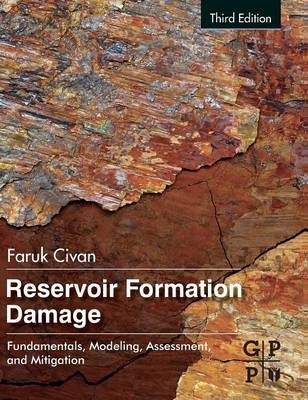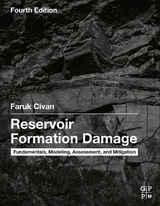
Reservoir Formation Damage
Gulf Professional Publishing (Verlag)
978-0-12-801898-9 (ISBN)
- Titel erscheint in neuer Auflage
- Artikel merken
The text helps readers better understand the processes causing formation damage and the factors that can lead to reduced flow efficiency in near-wellbore formation during the various phases of oil and gas production.
The third edition in the series provides the most all-encompassing volume to date, adding new material on conformance and water control, hydraulic fracturing, special procedures for unconventional reservoirs, field applications design, and cost assessment for damage control measures and strategies.
Faruk Civan is the Martin G. Miller Chair Professor of the Mewbourne School of Petroleum and Geological Engineering at the University of Oklahoma in Norman. He formerly held the Brian and Sandra O’Brien Presidential and Alumni Chair Professorships. Previously, he worked in the Chemical Engineering department at the Technical University of Istanbul, Turkey. Dr. Civan received an Advanced Engineering Degree from the Technical University of Istanbul, Turkey, a M.S. degree from the University of Texas at Austin, Texas, and a Ph.D. degree from the University of Oklahoma, Norman, Oklahoma. All of his degrees are in chemical engineering. Dr. Civan specializes in petrophysics and reservoir characterization; fossil and sustainable energy resources development; carbon sequestration; unconventional gas and condensate reservoirs; reservoir and well/pipeline hydraulics and flow assurance; formation and well damage modeling, diagnosis, assessment, and mitigation; reservoir and well analyses, modeling, and simulation; natural gas engineering, measurement, processing, hydrates, transportation, and storage; carbon dioxide sequestration; coalbed methane production; improved reservoir recovery techniques; corrosion protection in oil and gas wells; filtration and separation techniques; oil and gas processing, transportation, and storage; multiphase transport phenomena in porous media; environmental pollution assessment, prevention, and control; mathematical modeling and simulation, and solving differential equations by numerical methods including by the quadrature, cubature, and finite-analytic methods. Dr. Civan is the author of two books, has published more than 330 technical articles in journals, edited books, handbooks, encyclopedia, and conference proceedings, and presented worldwide more than 125 invited seminars and/or lectures at various technical meetings, companies, and universities. He teaches short industry courses on a number of topics worldwide. Additionally, he has written numerous reports on his funded research projects. Dr. Civan’s publications have been cited frequently in various publications, as reported by the Science Author Citation Index. He is a member of the Society of Petroleum Engineers and the American Institute of Chemical Engineers. and a member of the editorial boards of several journals. He has served on numerous petroleum and chemical engineering, and other related conferences and meetings in various capacities, including as committee chairman and member, session organizer, chair or co-chair, and instructor. Civan has received 21 honors and awards, including five distinguished lectureship awards and the 2003 SPE Distinguished Achievement Award for Petroleum Engineering Faculty and the 2014 SPE Reservoir Description and Dynamics Award.
1. Overview of Formation Damage
PART I - Characterization of Reservoir Rock for Formation Damage—Reservoir Formations, Description and Characterization, Damage Potential, and Petrographics 2. Description and Characterization of Oil and Gas Reservoirs for Formation Damage Potential 3. Petrographical Characteristics of Petroleum-Bearing Formations
PART II - Characterization of the Porous Media Processes for Formation Damage—Porosity and Permeability, Mineralogy Sensitivity, Petrophysics, Rate Processes, Rock-Fluid-Particle Interactions, and Accountability of Phases and Species 4. Alteration of the Porosity and Permeability of Geological Formations- Basic and Advanced Relationships 5. Mineral Sensitivity of Petroleum–Bearing Formations 6. Petrophysical Alterations– Fluid Disposition, Distribution, and Entrapment, Flow Functions, and Petrophysical Parameters of Geological Formations 7. Phase Equilibria, Solubility, and Precipitation in Porous Media 8. Particulate Processes in Porous Media 9. Multi-Phase and Multi-Species Transport in Porous Media
PART III - Formation Damage by Particulate Processes—Single- and Multi-Phase Fines Migration, Clay Swelling, Filtrate and Particulate Invasion, Filter Cake, Stress Sensitivity, and Sanding 10. Single-Phase Formation Damage by Fines Migration and Clay Swelling 11. Multi-Phase Formation Damage by Fines Migration 12. Cake Filtration: Mechanism, Parameters and Modeling 13. Injectivity of the Waterflooding Wells 14. Drilling-Induced Near-Wellbore Formation Damage: Drilling Mud Filtrate and Solids Invasion and Mudcake Formation 15. Reservoir Stress-Induced Formation Damage: Formation Compaction, Subsidence, Sanding Tendency, Sand Migration, Prediction and Control, and Gravel-Pack Damage
PART IV - Formation Damage by Inorganic and Organic Precipitation Processes—Chemical Reactions, Saturation Phenomena, Dissolution, Precipitation, and Deposition 16. Inorganic Scaling and Geochemical Formation Damage 17. Formation Damage by Organic Deposition
PART V - Laboratory Assessment of the Formation Damage Potential—Instrumental Techniques, Testing, Analysis, and Interpretation 18. Instrumental and Laboratory Techniques for Characterization of Reservoir Rock 19. Laboratory Evaluation of Formation Damage
PART VI - Field Diagnosis and Mitigation of Formation Damage—Measurement, Assessment, Control, and Remediation 20. Field Diagnosis and Measurement of Formation Damage 21. Determination of Formation- and Pseudo-Damage from Well Performance- Identification, Characterization, and Evaluation 22. Formation Damage Control and Remediation- Fundamentals 23. Reservoir Formation Damage Abatement- Guidelines, Methodology, Preventive Maintenance, and Remediation Treatments
PART VII - Modeling and Simulation of Formation Damage- Prediction of the Near-Wellbore Formation Damage and the Combined Effects of Fluid, Completion, and Formation Damages on Well Performance by Various Modeling and Simulation Approaches and Examples 24. Near-Wellbore Formation Damage by Inorganic and Organic Precipitates Deposition 25. Interactions and Coupling of Reservoir Fluid, Completion, and Formation Damages 26. Formation Damage Simulator Development 27. Model Assisted Analysis and Interpretation of Laboratory and Field Tests
| Erscheint lt. Verlag | 23.9.2015 |
|---|---|
| Sprache | englisch |
| Maße | 191 x 235 mm |
| Gewicht | 2330 g |
| Themenwelt | Technik ► Elektrotechnik / Energietechnik |
| ISBN-10 | 0-12-801898-4 / 0128018984 |
| ISBN-13 | 978-0-12-801898-9 / 9780128018989 |
| Zustand | Neuware |
| Informationen gemäß Produktsicherheitsverordnung (GPSR) | |
| Haben Sie eine Frage zum Produkt? |
aus dem Bereich



